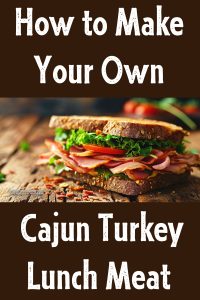How to Make Your Own Cajun Turkey Lunch Meat – The Organic Prepper

(Psst: The FTC wants me to remind you that this website contains affiliate links. That means if you make a purchase from a link you click on, I might receive a small commission. This does not increase the price you’ll pay for that item nor does it decrease the awesomeness of the item. ~ Daisy)
In a previous article, How to Make Your Own Lunch Meat, we made a garlic, onion and herb roast beef. As I promised, now we’re making a Cajun-seasoned roasted turkey lunch meat.
I was looking for a boneless, skinless turkey breast but did not find one. It must be a Thanksgiving thing. I did find a bone-in, skin-on, frozen turkey breast at $18.42 for 6.16 lbs.
I bought two different kinds of seasoning. One, a dry general, 5oz of Cajun seasoning containing salt, paprika, red pepper, thyme, black pepper, celery seed, garlic and onion. 5oz of seasoning may not sound like much, but it was about a cup and a quarter of seasoning. The second was a dry Creole seasoning containing sea salt, organic dehydrated onion, garlic, paprika, cane sugar, natural hickory smoke flavor (what the heck is that?), and safflower oil. The first will be used in the brine, and the second will be applied to the breast just before roasting.
Again, using the book Charcuterie: The Craft of Salting, Smoking, and Curing by Michael Ruhlman and Brian Polcyn, I made a basic brine. I highly recommend this book for your own library.
Brining meat does three things:
1) It changes the meat cells at the molecular level, allowing the cells to plump with water, thereby making the meat moist. You can do the same thing with a whole turkey to prevent it from becoming dry at Thanksgiving dinner. I have done that in the past.
2) It infuses whatever seasoning or flavors you want to add. I made the above-mentioned Thanksgiving turkey with an Earl Grey tea infusion. It turned out great!
3) The salt acts as a preservative, preventing bacteria from forming in the short term, more so than unbrined meat.
The basic brine is:
I took half a gallon of water, put it in a bowl, and put it in the freezer to chill while I made the brine.
I put the other half of a gallon of water into a large sauce pan, mixed in the salt and sugar, and brought it to a boil, occasionally stirring until all the salt and sugar dissolved. I let it cool until just warm.
I then took the turkey breast and put it in a 2.5-gallon plastic zip-lock bag. I added the chilled water, then the Cajun seasoning, and then the warm brine. I secured the bag and placed it in the fridge. I used the charcuterie book’s guidelines for brining a 4 lb chicken and a full 15 lb turkey and split the difference of 18 hours. I drained and discarded the brine, rinsed the turkey breast, and then let it rest in the fridge for three hours.
Pre-heat the oven to 325 degrees.
While the oven was pre-heating, I cut the skin away, exposing the breast, leaving the skin on by the base of the back at the bottom next to the bottom of a cast iron roasting pan. Save that and the turkey carcass for later to make a very interesting stock. Never let anything go to waste! I used the Creole seasoning blend and packed it around the breast, down into the cavity and some around the skin.
Roast in the oven for 2 ¼ to 2 ½ hours or when the breast reads 165 degrees, not touching bone, on an instant read thermometer.
The Creole seasoning did make the surface of the breast a bit salty, but not unpleasantly so. The meat in the center, with no Creole seasoning, was moist and had a nice mild Cajun flavor. It was awesome!
Once cool, I put it in a bowl in the fridge as I had other things to do. Later, when I went into the fridge for something, I found my wife had been snacking, stripping off the top layers. It was so good, and she is not usually a fan of Cajun-like seasoning.
I cut the breast away from the bone, divided them into three different portions, wrapped them, and put them in the freezer for later use.
Up next, I am pondering the idea of a Jamaican Jerk chicken breast wrapped in bacon. If I could have found a boneless, skinless turkey breast as my original intent, I would have wrapped it in bacon, but no joy.
If you have any suggestions and would like to see me give it a go, I would love to hear them in the comments section!
1stMarineJarHead is not only a former Marine, but also a former EMT-B, Wilderness EMT (courtesy of NOLS), and volunteer firefighter.
He currently resides in the great white (i.e. snowy) Northeast with his wife and dogs. He raises chickens, rabbits, goats, occasionally hogs, cows and sometimes ducks. He grows various veggies and has a weird fondness for rutabagas. He enjoys reading, writing, cooking from scratch, making charcuterie, target shooting, and is currently expanding his woodworking skills.
